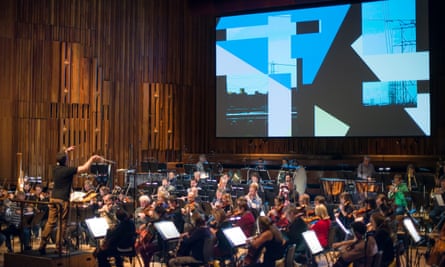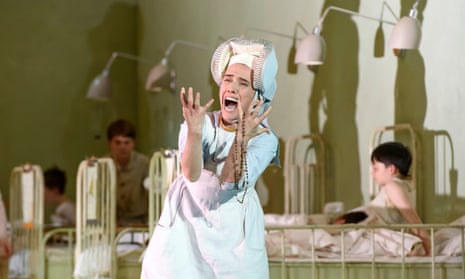A dimly lit quayside drab with poverty and toil. A women’s cloister spotless but for the stain of indelible sin. The bedroom of a dying man made all the more airless by the gabbing and pecking of his greedy family. Three worlds, three sets of desires and three operas. Puccini described his Il trittico, with some bathos, as a work about “great sorrow in little souls”. We see it complete all too rarely, chiefly for practical reasons of scale, large cast and a long evening, though let’s not forget that Opera Holland Park pulled off a great staging last year.
Richard Jones’s brilliant 2011 production for the Royal Opera has been revived. I attended the second performance. The conductor, Nicola Luisotti, may not mine Puccini’s score with quite the same range of finely calibrated emotion found by Antonio Pappano last time round, but he honours all three scores, as do the ROH orchestra. Il tabarro (The Cloak) is often perceived, in this production too, as the weakest. On the contrary, in Ultz’s designs it has a raw, hard quality, which suits the oppressive cruelty of the situation: a husband and wife trapped in the pain of a lost child, and her lover who seems to offer redemption and pleasure. Lucio Gallo (Michele) and Carl Tanner (Luigi) express those complex layers of feeling, but Patricia Racette’s vocally powerful Giorgetta lays bare a soul racked with anguish.
In Suor Angelica, another soul in torment, another lost infant, the opera belongs to Ermonela Jaho reprising the title role. She acts superbly. Her half-voice, sustained with astonishing security and variety, reflects both stoicism and frailty. Jaho’s performance is the one we’ll all remember in this Trittico. Anna Larsson as the icy Princess and an ensemble of starched nuns complete an ideal cast. Miriam Buether’s clinical designs – updated to an American Catholic children’s hospital c1960, all eau-de-nil and, one suspects, eau de vie – still looks stunning.
As for Gianni Schicchi, first performed in this staging in 2007 as a double bill with Ravel’s L’heure espagnole, it continues to offer the laughter and wit that (almost) make you wish Puccini had chosen more comedy for his final work instead of the decidedly unfunny Turandot. Back in the title role of Schicchi, Lucio Gallo was laconic and cunning. Of the large cast, Gwynne Howell, Jeremy White, Marie McLaughlin and Rebecca Evans stood out. Susanna Hurrell and Paolo Fanale were delightful, elegant-voiced sweethearts. Elena Zilio as cousin Zita has an entire comedy act compressed into her small but vital role. Her shriek of “ladro” – thief – would reduce the whole of Tuscany’s carabinieri to a quiver.
Agon – the Greek word means struggle, or contest – was Stravinsky’s final ballet, composed for the Russian-American choreographer George Balanchine. Marcel Duchamp likened its impact, at the New York premiere in 1957, to that of The Rite of Spring more than 40 years earlier. It remains, however, a relative rarity in the concert hall. Full of baroque influence, with prominent use of solo instruments (notably violin, mandolin and harp), it gleams and dazzles with cool, streamlined vigour, the epitome of modernism. The work opened a BBC Symphony Orchestra concert which also included his Symphony of Psalms (1930), potently sung by the BBC Symphony Chorus. There are no soloists in this austere yet heart-rending work. The final, far from traditional hymn of praise, with seemingly endless repetitions of “laudate” to the quiet urging of a constant, six-note throbbing figure in timpani and two pianos, was tenderly achieved by players, singers and the conductor Ryan Wigglesworth.

Then this talented musician, also a pianist, turned composer. The soloist in his Violin Concerto was Barnabás Kelemen, whose poetic and lyrical playing suited Wigglesworth’s ingeniously coloured score. Unexpectedly it begins and ends quietly, questing rather than stating, building to a noisy Allegro furioso and coming to rest with a whispered and wistful farewell. The work has been recorded by NMC: have a listen.
The last work was Britten’s Sea Interludes from Peter Grimes, daringly as close to illustration as music can get. These are the moments in the opera, usually, when the curtain comes down and the swirl and sparkle and mist and ferment of the North Sea off the Suffolk coast play on your mind’s eye. This was not so here. Four major orchestras, from Miami, Philadelphia, Los Angeles and San Francisco, had commissioned video projections, called “visual interpretations” and new to the UK, from the American graphic designer Tal Rosner. The BBCSO added the Passacaglia from Grimes as a fifth video commission, here receiving its world premiere.
They were not for me. The BBCSO played with verve and characteristic expertise while mechanistic collages of squares and lines, intercut with cityscapes, bridges and rivers, moved ceaselessly behind them like an enormous screensaver. It brought to mind the opening titles of Dallas. The question of how to enliven the concert experience – though the Sea Interludes have always felt quite lively to me – is real enough, that of how to use visuals without detracting from the music equally foxing. The difficulty is that Rosner’s images take their energy from Britten’s score and drain it in the process. The experiment continues. I did ask myself what, if anything, I would want to see while listening to this music. A webcam on Aldeburgh beach might be an answer.
Star ratings (out of 5)
Il trittico ****
BBC Symphony Orchestra/Wigglesworth ****

Comments (…)
Sign in or create your Guardian account to join the discussion